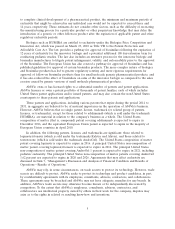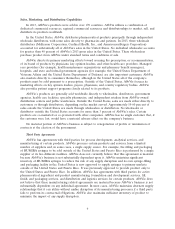AbbVie 2013 Annual Report Download - page 19
Download and view the complete annual report
Please find page 19 of the 2013 AbbVie annual report below. You can navigate through the pages in the report by either clicking on the pages listed below, or by using the keyword search tool below to find specific information within the annual report.detailed studies may demonstrate additional benefits that can help in the marketing, but they also
consume time and resources and may delay submitting the pharmaceutical product candidate for
approval. AbbVie cannot guarantee that a proper balance of speed and testing will be made with
respect to each pharmaceutical product candidate or that decisions in this area would not adversely
affect AbbVie’s future results.
Even if AbbVie successfully develops and markets new products or enhancements to its existing
products, they may be quickly rendered obsolete by changing clinical preferences, changing industry
standards, or competitors’ innovations. AbbVie’s innovations may not be accepted quickly in the
marketplace because of existing clinical practices or uncertainty over third-party reimbursement.
AbbVie cannot state with certainty when or whether any of its products under development will be
launched, whether it will be able to develop, license, or otherwise acquire compounds or products, or
whether any products will be commercially successful. Failure to launch successful new products or new
indications for existing products may cause AbbVie’s products to become obsolete, causing AbbVie’s
revenues and operating results to suffer.
A portion of AbbVie’s near-term pharmaceutical pipeline relies on collaborations with third parties, which
may adversely affect the development and sale of its products.
AbbVie depends on alliances with pharmaceuticals and biotechnology companies for a portion of
the products in its near-term pharmaceutical pipeline. For example, AbbVie is collaborating with
Biogen Idec to develop a treatment for the relapsing remitting form of multiple sclerosis. It is also
collaborating with Galapagos NV to discover, develop, and commercialize a next-generation, oral Janus
Kinase 1 (JAK1) inhibitor in Phase II development with the potential to treat multiple autoimmune
diseases.
Failures by these parties to meet their contractual, regulatory, or other obligations to AbbVie, or
any disruption in the relationships between AbbVie and these third parties, could have an adverse
effect on AbbVie’s pharmaceutical pipeline and business. In addition, AbbVie’s collaborative
relationships for research and development extend for many years and may give rise to disputes
regarding the relative rights, obligations and revenues of AbbVie and its collaboration partners,
including the ownership of intellectual property and associated rights and obligations. This could result
in the loss of intellectual property rights or protection, delay the development and sale of potential
pharmaceutical products, and lead to lengthy and expensive litigation or arbitration.
Biologics carry unique risks and uncertainties, which could have a negative impact on future results of
operations.
The successful discovery, development, manufacturing and sale of biologics is a long, expensive and
uncertain process. There are unique risks and uncertainties with biologics. For example, access to and
supply of necessary biological materials, such as cell lines, may be limited, and governmental
regulations restrict access to and regulate the transport and use of such materials. In addition, the
development, manufacturing, and sale of biologics is subject to regulations that are often more complex
and extensive than the regulations applicable to other pharmaceutical products. Manufacturing
biologics, especially in large quantities, is often complex and may require the use of innovative
technologies. Such manufacturing also requires facilities specifically designed and validated for this
purpose and sophisticated quality assurance and quality control procedures. Biologics are also
frequently costly to manufacture because production inputs are derived from living animal or plant
material, and some biologics cannot be made synthetically. Failure to successfully discover, develop,
manufacture and sell biologics—including HUMIRA—could adversely impact AbbVie’s business and
results of operations.
15
























